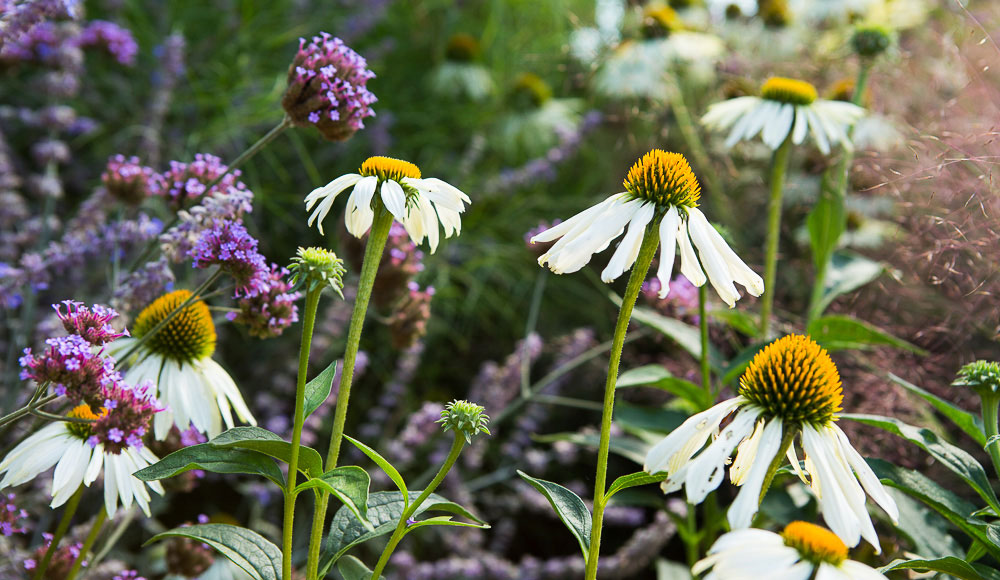


By Emily Murphy
What would summer be without flowers? The warm months of summer are when many of the varieties we know and love bloom, making every day a better day. In fact, planting even a few flowers has helpful benefits for you and your community. Adding flowers to your garden will actively supporting critical wildlife like pollinators by providing nectar sources and habitat. Plus they offer hidden health benefits. It has long been found that simply looking at flowers improves mood, reduces stress, and boosts concentration. If you’re growing flowers for the first time or adding them to an existing garden, here are a few tried and true varieties to consider.

Echinacea is a fabulous, short lived perennial that will sometimes volunteer (self-sow) or can be reseeded from one season to the next. These flowers hold their own in perennial borders, meadow gardens, and herb gardens. Grow it as a cut flower or to attract wildlife. Echinacea can also grow into winter when the spent blooms are just as beautiful. Its daisy shaped, long-lasting blooms make it appealing to butterflies, birds, and bees. Give it good soil and consistent watering with a bubbler, soaker hose, or Thumb Control Watering Nozzle. Water two or three times a week, making sure the first four inches of the soil stay moist but not saturated.

These annuals pair well with perennials and will fill any sunny spot. Once they take hold, zinnias don’t falter until cooler temperatures arrive in fall, providing months of blooms. A healthy zinnia produces so many blooms that there are plenty for cutting as well as for wildlife. Plant it from seed or starts in your kitchen garden, alongside sunflowers, or near your front walkway. Water zinnias deeply, aiming for the root zone, using a soaker hose or hose and a Thumb Control Watering Nozzle paired with a Flexogen Super Duty Hose.

Ornamental basils like ‘African Blue,’ ‘Magic Mountain,’ and ‘Wild Magic’ have become a staple in my garden. They are generally not harvested for eating, but they have fabulous fragrances that deter mosquitos and produce blooms that bees love. Water them regularly after planting. Once they are established, reduce watering to about 3 times per week depending on the weather.

Plant Hydrangea to form a border, to fill a shady spot in your garden or near your door where it’s easy to bring blooms inside. They prefer rich, well-draining but moist soil, which is easy to achieve with a soaker hoses or a Thumb Control Watering nozzle. Give hydrangeas morning sun and afternoon shade whenever possible. Compost or mulch flowers in spring and fall for optimal growth.

Lavender is a flower that is also an herb. Its mood boosting fragrance is known to be calming and restorative. Mix these flowers into homemade soaps, herb sachets, or try lavender honey vanilla ice-cream. For best results, grow lavender from starts or cuttings. Plant it in groups, as a focal point, or to form a perennial border. It tolerates poor to moderate soil and is incredibly water wise.

Multi-purpose nasturtiums can be grown for their charming foliage and flowers, that serve as food, or to lure aphids away from your veggie garden. Toss its leaves and blossoms into a summer salad or pickle the seeds to make “poor man’s” capers. Grow nasturtium in a patio garden, flower garden, or kitchen garden. It tumbles out of containers and along garden walks thanks to its vine-like nature. Be sure to give it good soil and regular water.

It’s hard not to love the lighthearted, exuberant nature of cosmos. It’s what I call a make-you-smile plant. Technically an herbaceous perennial, cosmos will return from one season to the next in warmer climates. However, in cooler climates, you need to reseed. Growing it from seed gives you far more varieties to choose from than what you can typically find in starts.

Also known as pansies or “Johnny-Jump Up” flowers, violas can be sown from seed or starts. It’s best to plant in early spring as soon as soil can be worked and again in mid-summer for a fall bloom. Add the flowers to salads or sugar them to decorate cakes and other desserts. Violas grow best along the edges of kitchen garden beds, in perennial borders, in window boxes, and in container gardens. Make sure to plant in rich, well-draining soil and water regularly.

Growing sunflowers from seed may allow you to have volunteers, self-sowing flowers, which can easily be transplanted the following season. Varieties like “Mammoth Russian,” “Hopi Black Dye,” “Super Snack Mix,” and “Royal Hybrid” are all good eating and flowering varieties. Some varieties like “Sunfinity” are perfect to add to borders and cutting gardens. Give them plenty of sun, good soil, and regular water.

Veronica, also known as speedwell, is a hardy perennial that pairs well with sage varieties like Salvia nemorosa. When your Salvia blooms begin to fade, Veronica takes its place. It thrives in full sun to part shade, prefers well-draining soil, and is fairly water wise once established. Water 2 to 3 times weekly, depending on summer rain and heat, using your Flexogen Super Duty Hose and Thumb Control Watering Nozzle.
From the moment you pick it up, you’ll notice these nozzles are different. Designed with mobility in mind, they feature Gilmour’s innovative Swivel Connect. The swivel allows the nozzles to pivot without
Learn MoreWinter Gardening Tips to Tackle in the Off Season
As winter marches on, avid gardeners become more and more eager to get growing. While you may not be able to dig your spade into the soil just yet, there is plenty
Learn MoreDesign a Beautiful Drought Resistant Yard
Hot weather and drought-like conditions don’t mean a beautiful yard and garden is out of reach. Learn everything you need to know about drought tolerant landscaping, including the best type of plants,
Get the Dirt